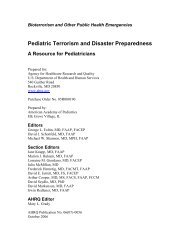(HPP) Performance Measure Manual
(HPP) Performance Measure Manual
(HPP) Performance Measure Manual
You also want an ePaper? Increase the reach of your titles
YUMPU automatically turns print PDFs into web optimized ePapers that Google loves.
INTRODUCTION<br />
Table 5: Definitions of Logic Model Components:<br />
Component<br />
Inputs<br />
Activities<br />
Outputs<br />
Outcomes<br />
Definition<br />
Resources that are required to support the program, including staff and volunteers, funding,<br />
facilities, and equipment.<br />
Actions that use or involve program inputs.<br />
Products and services produced by program activities.<br />
Changes or benefits resulting from program activities and outputs. Outcomes can be intended<br />
or unintended, positive or negative, and are often divided into short term, intermediate, and<br />
long-term timeframes.<br />
Introduction<br />
What are the benefits of program evaluation?<br />
There are numerous benefits to program evaluation, which include:<br />
• Identifying program successes<br />
• Identifying areas for improvement and increased efficiency<br />
• Understanding the overall program or in part its contributions<br />
• Increasing “buy-in” of staff, volunteers, collaborators, new partners, funders and the public<br />
Improving services provided through better management and monitoring 4<br />
• Disseminating program information<br />
<strong>Performance</strong> <strong>Measure</strong>ment as an Evaluation Strategy<br />
How does measurement link to evaluation?<br />
<strong>Measure</strong>ment is one evaluation strategy, among many others. <strong>Measure</strong>s may be developed for program<br />
inputs, activities, outputs, or outcomes, depending on the level of program development and<br />
implementation and programmatic areas of interest. Historically, <strong>HPP</strong> measures have focused on<br />
program activities and outputs, though as the program matures, so too does its measures.<br />
How are measurement data used?<br />
Just as with evaluation more broadly, measurement data can be used to facilitate internal program<br />
improvement and demonstrate accountability.<br />
Improvement measures are designed to provide data to awardees and ASPR staff to enable identification<br />
of strengths, weaknesses, and areas of improvement, along with opportunities for training and technical<br />
assistance. The intended use of this measurement data is to facilitate internal program improvement and<br />
learning. Most <strong>HPP</strong> measures have an improvement component.<br />
Accountability measures are collected in compliance with specific Federal requirements, statutes or<br />
initiatives such as the Pandemic and All-Hazards Preparedness Act (PAHPA), the Government<br />
<strong>Performance</strong> and Results Act (GPRA), and the Healthy People 2020 Initiative. Data from these measures<br />
are often reported to requesting agencies and other entities such as the US Department of Health and<br />
Human Services, the White House Office of Management and Budget (OMB), and others. Data from these<br />
accountability measures will be used to provide evidence to the aforementioned programs that the <strong>HPP</strong><br />
4 Mattesich, P.W. (2003). The Manager’s Guide to Program Evaluation: Planning, Contracting, and Managing for Useful Results. Saint Paul: Amherst H. Wilder<br />
Foundation.<br />
Hospital Preparedness Program (<strong>HPP</strong>) <strong>Performance</strong> <strong>Measure</strong> <strong>Manual</strong><br />
Guidance for Using the New <strong>HPP</strong> <strong>Performance</strong> <strong>Measure</strong>s Page | 5
















